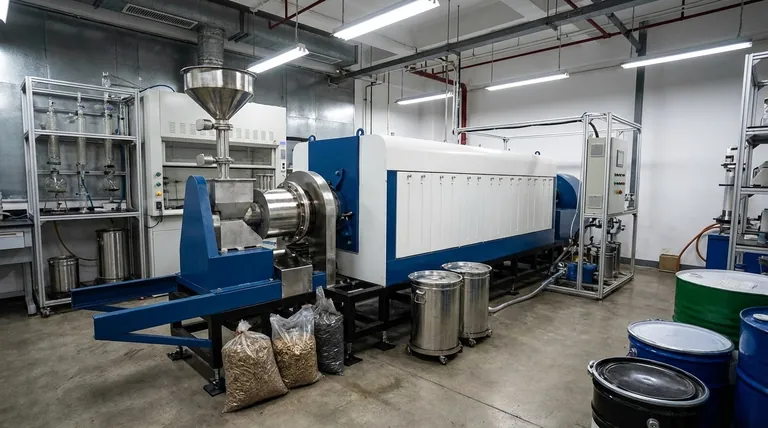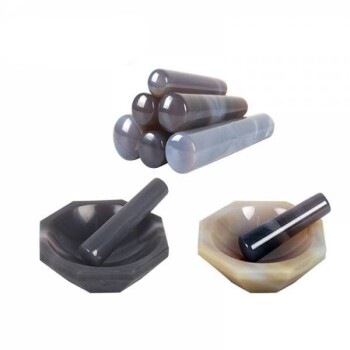At its core, bio-oil from pyrolysis is a versatile liquid fuel. It serves as a renewable substitute for traditional fossil fuels in a range of applications, from industrial heating and electricity generation to being a potential feedstock for advanced transportation biofuels.
Bio-oil offers a way to convert solid biomass into a more transportable and storable liquid energy source. However, its raw, acidic nature and lower energy content mean it often requires significant upgrading to be compatible with modern engines and infrastructure.

What Exactly is Pyrolysis Bio-Oil?
The Pyrolysis Process Explained
Pyrolysis is a process of thermal decomposition. Biomass, such as wood or agricultural waste, is heated rapidly to high temperatures (500-700°C) in an environment with very little oxygen.
This process breaks the solid material down without combustion, producing three key outputs: a liquid bio-oil (also called bio-crude), a solid biochar, and non-condensable synthesis gases (syngas). The bio-oil is condensed and collected from the vapor stream.
Key Properties of Raw Bio-Oil
The primary advantage of bio-oil is its liquid state. This makes it far easier to pump, store, and transport than the bulky, solid biomass it comes from. This liquefaction step is crucial for integrating biomass into existing liquid fuel supply chains.
Primary Applications for Bio-Oil
Direct Fuel for Heat and Power
The most common use for bio-oil is as a direct combustion fuel, replacing fuel oil or natural gas in stationary applications.
Industries that rely on large boilers, furnaces, or kilns—such as steel, iron, ceramics, and chemical plants—can use bio-oil as a source of heat. It can also be used in dedicated generators to produce electricity.
A Feedstock for Transportation Biofuels
With further processing, bio-oil can be upgraded into more refined biofuels, such as renewable gasoline or diesel. This makes it a candidate for use in the transportation sector.
However, raw bio-oil cannot be used directly in standard car engines. It requires significant chemical modification to become a stable, compatible fuel.
Understanding the Trade-offs and Challenges
While promising, raw bio-oil has several technical hurdles that limit its widespread, direct use. Understanding these challenges is critical to evaluating its role as a renewable fuel.
Lower Energy Content
The heating value of bio-oil is a significant consideration. By weight, it contains only about half the energy of conventional petroleum-based heating oil, meaning you need roughly twice as much to produce the same amount of heat.
Corrosive Nature
Bio-oil is highly acidic and contains a significant amount of water. This combination makes it corrosive to the common metals, like steel and iron, used in standard fuel tanks, pumps, and engine components.
Contaminants and Instability
The rapid production process can leave behind solid char particles and other chemical impurities. Over time, raw bio-oil can also thicken and separate, making it difficult to handle and use consistently.
The Critical Need for Upgrading
To overcome these limitations, bio-oil must often be stabilized and upgraded. Processes like hydroprocessing use hydrogen and catalysts to remove oxygen, reduce acidity, and increase the energy density, making the final product much more like conventional fossil fuels.
Making the Right Choice for the Application
The suitability of bio-oil depends entirely on the intended use and the level of processing it has undergone.
- If your primary focus is direct industrial heat: Raw or minimally-processed bio-oil can be a viable substitute for furnace oil, provided the equipment is designed or modified to handle its corrosive properties.
- If your primary focus is localized electricity generation: It can be effectively used in specially designed boilers and generators that can tolerate its unique chemical makeup.
- If your primary focus is advanced transportation fuel: Raw bio-oil is only a starting point; it must undergo significant and often costly upgrading to become a stable biofuel compatible with modern engines.
Ultimately, harnessing bio-oil's potential requires matching the right grade of the fuel to the right application.
Summary Table:
| Application | Bio-Oil Type | Key Considerations |
|---|---|---|
| Industrial Heating | Raw or minimally-processed | Requires equipment resistant to acidity and corrosion. |
| Electricity Generation | Raw or minimally-processed | Effective in specially designed boilers and generators. |
| Transportation Biofuels | Upgraded (e.g., hydroprocessed) | Requires significant chemical upgrading to be engine-compatible. |
Ready to integrate pyrolysis bio-oil into your energy strategy? KINTEK specializes in providing the robust lab equipment and consumables needed for biomass analysis and bio-oil research. Whether you're developing new upgrading processes or testing fuel compatibility, our solutions help you innovate with confidence. Contact our experts today to find the right tools for your laboratory's renewable energy projects.
Visual Guide

Related Products
- Electric Rotary Kiln Small Rotary Furnace Biomass Pyrolysis Plant
- Electric Rotary Kiln Continuous Working Small Rotary Furnace Heating Pyrolysis Plant
- Electric Rotary Kiln Pyrolysis Furnace Plant Machine Calciner Small Rotary Kiln Rotating Furnace
- Chemical Vapor Deposition CVD Equipment System Chamber Slide PECVD Tube Furnace with Liquid Gasifier PECVD Machine
- Automatic Laboratory Heat Press Machine
People Also Ask
- How is energy converted into biomass? Harnessing Nature's Solar Power for Renewable Energy
- Is pyrolysis viable? A Guide to Economic, Technological, and Environmental Success
- What are the different types of pyrolysis machines? Choose the Right System for Your Output
- What are the products of pyrolysis of biomass? Unlock Bio-Char, Bio-Oil, and Syngas
- What are the components of biomass pyrolysis? A Complete Guide to the System, Products, and Process














